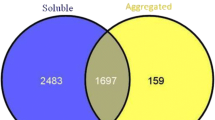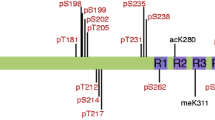Abstract
A number of proteins associated with neurodegenerative disease undergo several types of posttranslational modifications. They include N-linked glycosylation of the prion protein and amyloid precursor protein, phosphorylation of tau and α-synuclein. Posttranslational modifications alter physical properties of proteins including their net and surface charges, affecting their processing, life-time and propensity to acquire misfolded, disease-associated states. As such, analysis of posttranslational modifications is important for understanding the mechanisms of pathogenesis. Recent studies documented that sialylation of the disease-associated form of the prion protein or PrPSc controls the fate of prions in an organism and outcomes of prion infection. For assessing sialylation status of PrPSc, we developed a reliable protocol that involves two-dimensional electrophoresis followed by Western blot (2D). The current chapter describes the procedure for the analysis of sialylation status of PrPSc from various sources including central nervous system, secondary lymphoid organs, cultured cells, or PrPSc produced in Protein Misfolding Cyclic Amplification.
Access this chapter
Tax calculation will be finalised at checkout
Purchases are for personal use only
Similar content being viewed by others
References
Bolton DC, Meyer RK, Prusiner SB (1985) Scrapie PrP 27-30 is a sialoglycoprotein. J Virol 53:596–606
Schedin-Weiss S, Winblad B, Tjernberg LO (2014) The role of protein glycosylation in Alzheimer disease. FEBS J 281:46–62
Selden SC, Pollard TD (1983) Phosphorylation of microtubule-associated proteins regulates their interaction with actin filaments. J Biol Chem 258:7064–7071
Nakajo S, Tsukada K, Omata K et al (1993) A new brain-specific 14-kDa protein is a phosphoprotein. Its complete amino acid sequence and evidence for phosphorylation. Eur J Biochem 217:1057–1063
Katorcha E, Makarava N, Savtchenko R et al (2014) Sialylation of prion protein controls the rate of prion amplification, the cross-species barrier, the ratio of PrPSc glycoform and prion infectivity. PLoS Pathog 10:e1004366
Srivastava S, Makarava N, Katorcha E et al (2015) Post-conversion sialylation of prions in lymphoid tissues. Proc Natl Acad Sci U S A 112:6654–6662
Katorcha E, Daus ML, Gonzalez-Montalban N et al (2016) Reversible off and on switching of prion infectivity via removing and reinstalling prion sialylation. Sci Rep 6:33119
Srivastava S, Katorcha E, Daus ML et al (2017) Sialylation controls prion fate in vivo. J Biol Chem 292:2359–2368
Baskakov IV, Katorcha E (2016) Multifaceted role of sialylation in prion diseases. Front Neurosci 10:358
Katorcha E, Makarava N, Savtchenko R et al (2015) Sialylation of the prion protein glycans controls prion replication rate and glycoform ratio. Sci Rep 5:16912
Makarava N, Savtchenko R, Baskakov IV (2015) Two alternative pathways for generating transmissible prion disease de novo. Acta Neuropathol Commun 3:69
Makarava N, Savtchenko R, Baskakov IV (2013) Selective amplification of classical and atypical prions using modified protein misfolding cyclic amplification. J Biol Chem 288:33–41
Turk E, Teplow DB, Hood LE et al (1988) Purification and properties of the cellular and scrapie hamster prion proteins. Eur J Biochem 176:21–30
Endo T, Groth D, Prusiner SB et al (1989) Diversity of oligosaccharide structures linked to asparagines of the scrapie prion protein. Biochemistry 28:8380–8388
Stimson E, Hope J, Chong A et al (1999) Site-specific characterization of the N-linked glycans of murine prion protein by high-performance liquid chromatography/electrospray mass spectrometry and exoglycosidase digestions. Biochemistry 38:4885–4895
Stahl N, Baldwin MA, Teplow DB et al (1993) Structural studies of the scrapie prion protein using mass spectrometry and amino acid sequencing. Biochemistry 32:1991–2002
Rudd PM, Endo T, Colominas C et al (1999) Glycosylation differences between the normal and pathogenic prion protein isoforms. Proc Natl Acad Sci U S A 96:13044–13049
Katorcha E, Klimova N, Makarava N et al (2015) Knocking out of cellular neuraminidases Neu1, Neu3 or Neu4 does not affect sialylation status of the prion protein. PLoS One 10:e0143218
Stahl N, Baldwin MA, Hecker R et al (1992) Glycosylinositol phospholipid anchors of the scrapie and cellular prion proteins contain sialic acid. Biochemistry 31:5043–5053
Katorcha E, Srivastava S, Klimova N et al (2016) Sialylation of GPI anchors of mammalian prions is regulated in a host-, tissue- and cell-specific manner. J Biol Chem 291:17009–17019
Makarava N, Kovacs GG, Savtchenko R et al (2012) Stabilization of a prion strain of synthetic origin requires multiple serial passages. J Biol Chem 287:30205–30214
Gonzalez-Montalban N, Makarava N, Ostapchenko VG et al (2011) Highly efficient protein misfolding cyclic amplification. PLoS Pathog 7:e1001277
Acknowledgments
This work was supported by the National Institute of Health grant R01 NS045585.
Author information
Authors and Affiliations
Corresponding author
Editor information
Editors and Affiliations
Rights and permissions
Copyright information
© 2018 Springer Science+Business Media, LLC, part of Springer Nature
About this protocol
Cite this protocol
Katorcha, E., Baskakov, I.V. (2018). Analysis of Covalent Modifications of Amyloidogenic Proteins Using Two-Dimensional Electrophoresis: Prion Protein and Its Sialylation. In: Sigurdsson, E., Calero, M., Gasset, M. (eds) Amyloid Proteins. Methods in Molecular Biology, vol 1779. Humana Press, New York, NY. https://doi.org/10.1007/978-1-4939-7816-8_15
Download citation
DOI: https://doi.org/10.1007/978-1-4939-7816-8_15
Published:
Publisher Name: Humana Press, New York, NY
Print ISBN: 978-1-4939-7815-1
Online ISBN: 978-1-4939-7816-8
eBook Packages: Springer Protocols




